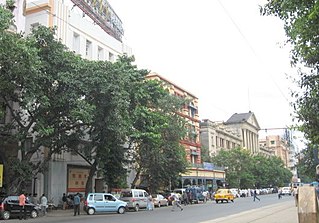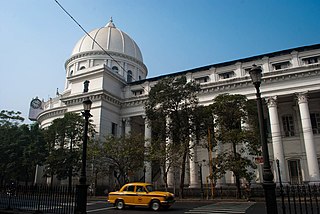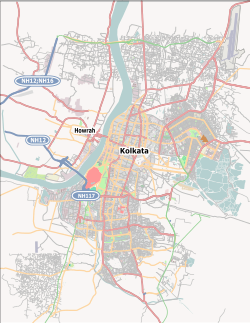
Sealdah Railway Station is one of India's major railway terminals serving the city of Kolkata. It is the second largest railway station in India and West Bengal in terms of platforms, tracks and overall daily passenger holding capacity. The other main railway stations in the Kolkata metropolitan area are Howrah, Shalimar, Kolkata and Santragachi. Over 1.5 million passengers use the station daily. It is an important suburban rail terminal. Kolkata Metro Line 2 passes through Sealdah with the new underground Sealdah metro station.

Esplanade is a neighbourhood of Central Kolkata, located at the heart of city with being the city's Central business district. This is a conventional esplanade because the Ganga river (Ganges), also known as Hooghly river, flows nearby and it is adjacent to the large fields of Maidan extending up to Fort William.

Benoy Krishna Basu, Benoy Basu, or Benoy Bose was an Indian revolutionary against British rule in India, who launched an attack on the Secretariat Building; the Writers' Building at the Dalhousie square in Kolkata, along with Badal Gupta and Dinesh Chandra Gupta.

Dinesh Chandra Gupta or Dinesh Gupta was an Indian revolutionary against British rule in India, who is noted for launching an attack on the Secretariat Building - the Writers' Building in the Dalhousie square in Calcutta, along with Badal Gupta and Benoy Basu.

Badal Gupta, real name Sudhir Gupta, was an Indian revolutionary against British rule in India, who is noted for launching an attack on the Secretariat Building - the Writers' Building in the Dalhousie square in Calcutta, along with Benoy Basu and Dinesh Gupta.

The Writers' Buildings or Mahakaran, often shortened to just Writers', is the official secretariat building of the state government of West Bengal in Kolkata, India. The 150-metre long building covers the entire northern stretch of the Lal Dighi or Red Lake at the centre of historic B.B.D. Bagh, long considered as the administrative and business hub of the city.

Raj Bhavan is the official residence of the Governor of West Bengal, located in Kolkata, the capital of West Bengal. Built in 1803, it was known as Government House during the Company rule in India and the British Raj.

The General Post Office, Kolkata is the central post office of the city of Kolkata, India, and the chief post office of West Bengal. The post office handles most of the city's inbound and outbound mail and parcels. Situated in the B. B. D. Bagh area, the imposing structure of the GPO is one of the landmarks in the city.

Kalikata was one of the three villages which were merged to form the city of Kolkata in India. The other two villages were Gobindapur and Sutanuti. Job Charnock, an administrator with the British East India Company is traditionally credited with the honour of founding the city. He settled in the village of Sutanuti.

Calcutta Tramways Company (CTC) was a state-run company that operated trams and buses in and around Kolkata in West Bengal, India. The Kolkata tram is the only operating tramway in India and is the oldest electric tram in India, operating since 1902.

Lalbazar is a neighbourhood in Central Kolkata, earlier known as Calcutta, in the Indian state of West Bengal. It is part of the central business district adjoining B.B.D. Bagh area. The headquarters of the Kolkata Police is located here and is popularly known by the same name.

Bagbazar is a neighbourhood of North Kolkata, in Kolkata district in the Indian state of West Bengal. The area, under Shyampukur police station of Kolkata Police, has been, along with neighbouring Shyambazar, the citadel of the Bengali aristocracy. Bagbazar has played an active role in growth and development of Kolkata.

Netaji Subhas Road, previously known as Clive Street, is an important thoroughfare in Central Kolkata that runs predominantly north to south in the B. B. D. Bagh neighborhood of Kolkata.
Ward No. 46, Kolkata Municipal Corporation is an administrative division of Kolkata Municipal Corporation in Borough No. 6, covering parts of Chowringhee, Esplanade East, Dharmatala, Janbazar, Lalbazar, Bowbazar and Maidan neighbourhoods in central Kolkata, in the Indian state of West Bengal.

Mahakaran, is a metro station on Line 2 of Kolkata Metro, located in B.B.D. Bagh. There are many British heritage buildings near the station with the Lal Dighi adjoining it. The tracks leaving the station towards Howrah go underneath the Hooghly river through the biggest underwater metro tunnel of India. The station was completed and opened on 6 March 2024. The station, though comparing without platform screen doors, my look similar to any Line-1 underground station, but it is actually very different as it is designed with world class facilities and murals that pay tribute to the locality and Indian freedom fighters. The nearest railway station is B.B.D. Bagh railway station. Just before the tunnel enters the underwater segment, lies a ventilation shaft on the Kolkata bank of Hooghly River, which is the deepest of its kind in India, at 44 metres (144 ft) below ground level.

The Currency Building is an early 19th-century building in the B. B. D. Bagh central business district of Kolkata in West Bengal, India. The building was originally built in 1833 to house the Calcutta branch of the Agra Bank. In 1868, it was converted for use by the Office of the Issue and Exchange of Government Currency, an office of the Controller of the Currency under the British Raj. From 1935 until 1937, the Reserve Bank of India (RBI) used the building as its first central office. The building remained in use, and was used at one time by the Central Public Works Department (CPWD) as a storehouse. Authorities decided to demolish it in 1994.

8/12 Binay Badal Dinesh is a 2022 Bengali-language historical drama film directed by Arun Roy, produced by Kan Singh Sodha based on the historical attack on Writers' Building by three Bengal Volunteers in 1930. The film was released on 26 January 2022 under the banner of KSS Productions and Entertainment.

Lal Dighi, also called the Tank Square or Dalhousie Square is a man-made water tank in Kolkata, India.

















































